Abstract
Sulfur-containing amino acids were examined as precursors for thiols in anoxic coastal sediments. Substrates (10 to 100 μM) were anaerobically incubated with sediment slurries; thiols were assayed as isoindole derivatives by high-performance liquid chromatography; and microbial transformations of thiols, in contrast to their chemical binding by sediment particles, were identified by inhibition with a mixture of chloramphenicol and tetracycline. Methionine and homocysteine were transformed to methanethiol and 3-mercaptopropionate (3-MPA); methionine stimulated mainly methanethiol production, whereas homocysteine generated more 3-MPA than methanethiol. 2-Keto-4-methiolbutyrate yielded results similar to those with methionine, indicating that demethiolation yields methanethiol at the keto-acid level. Glutathione gave rise to cysteine, which was further transformed to 3-mercaptopyruvate and thence to mercaptoacetate and mercaptoethanol. Mercaptoethanol was oxidized to mercaptoacetate, which was biologically consumed. In conclusion, sulfurcontaining amino acids contribute to the range of thiols that occur in anoxic coastal sediments. New metabolic and environmental transformations were identified: the production of 3-MPA as a metabolite of methionine and the transformation of mercaptopyruvate to mercaptoethanol and mercaptoacetate.
Full text
PDF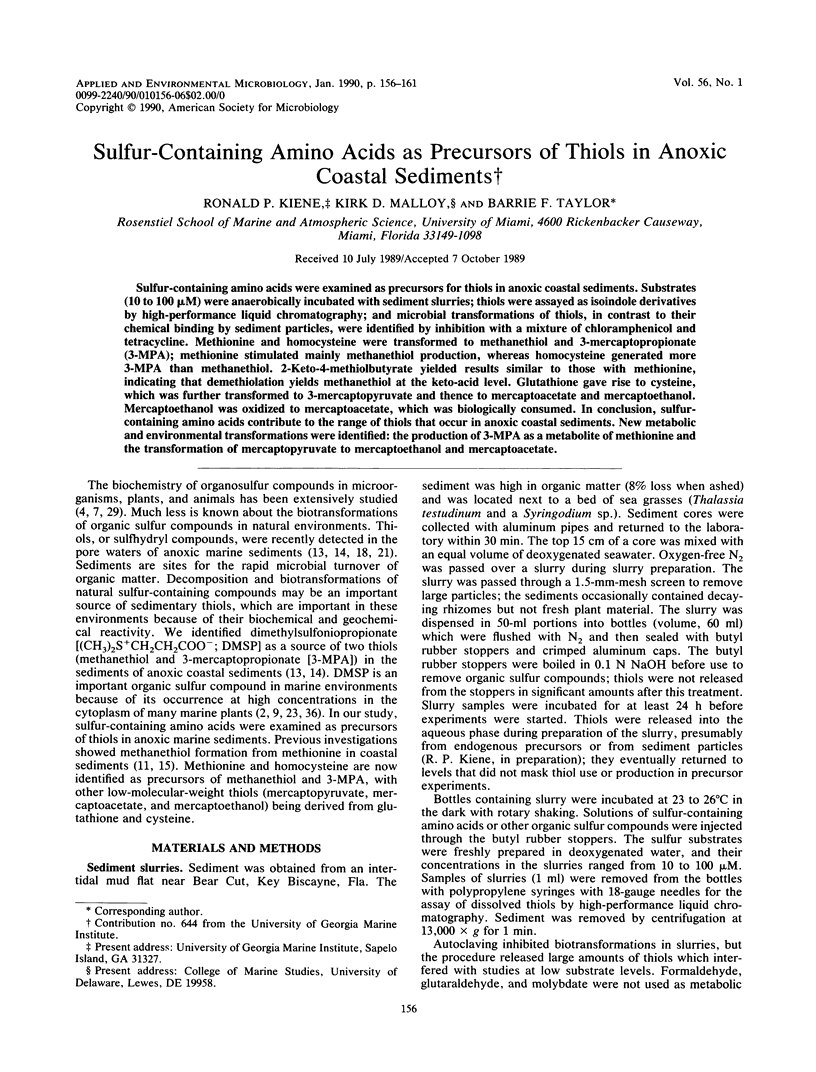

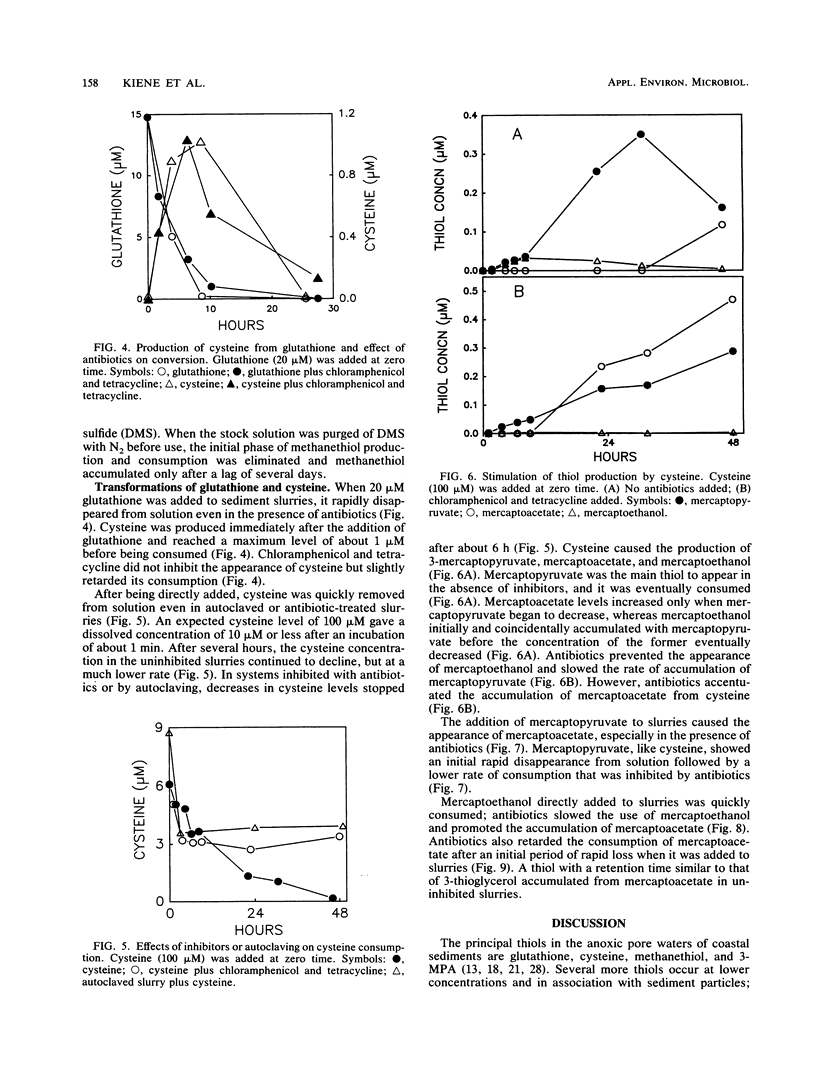
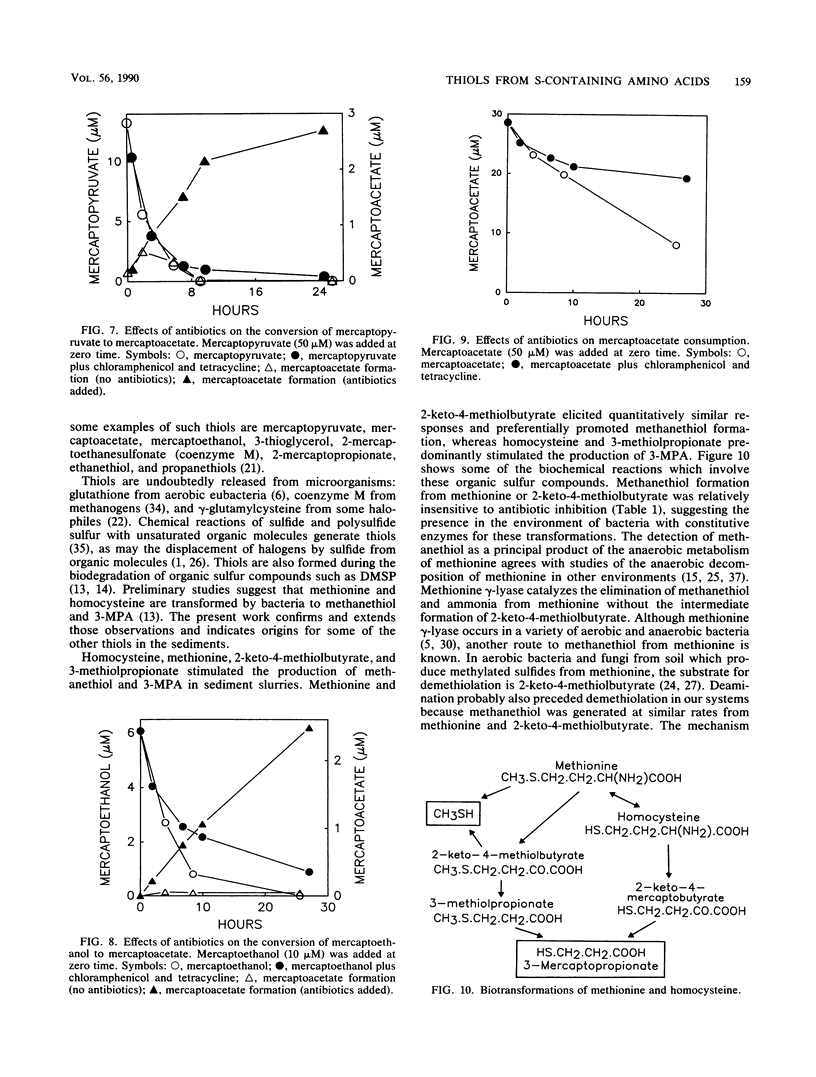
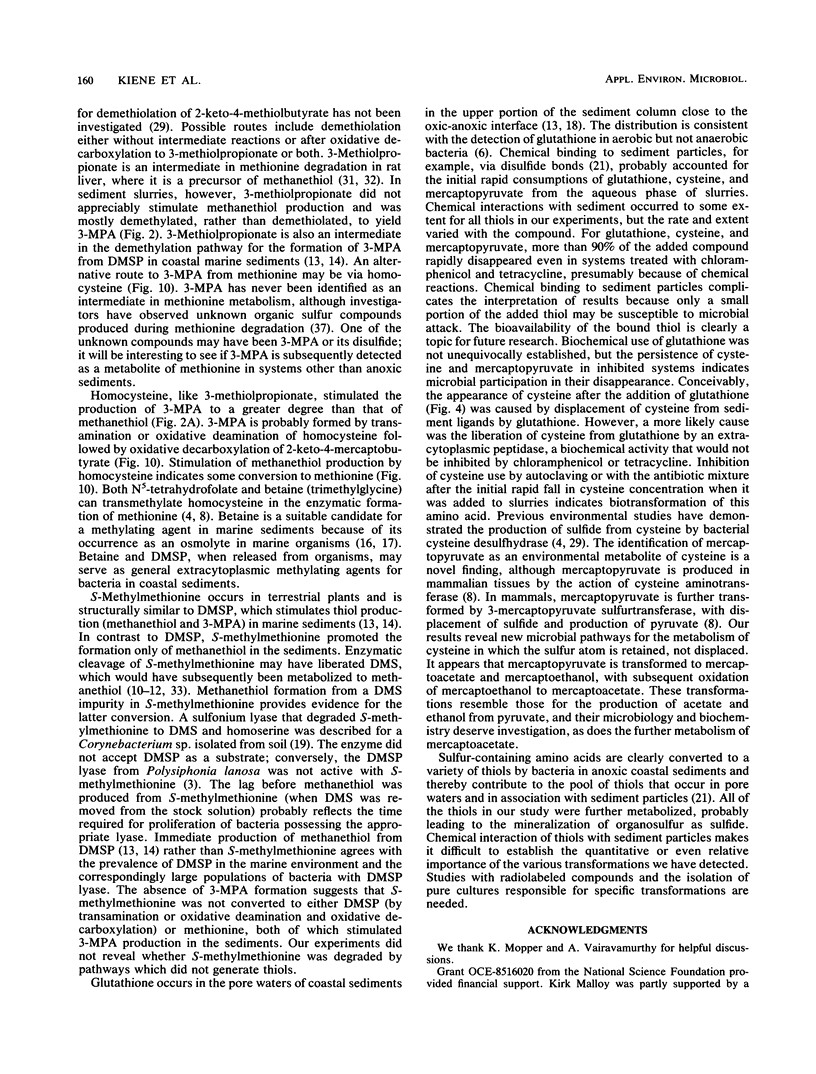
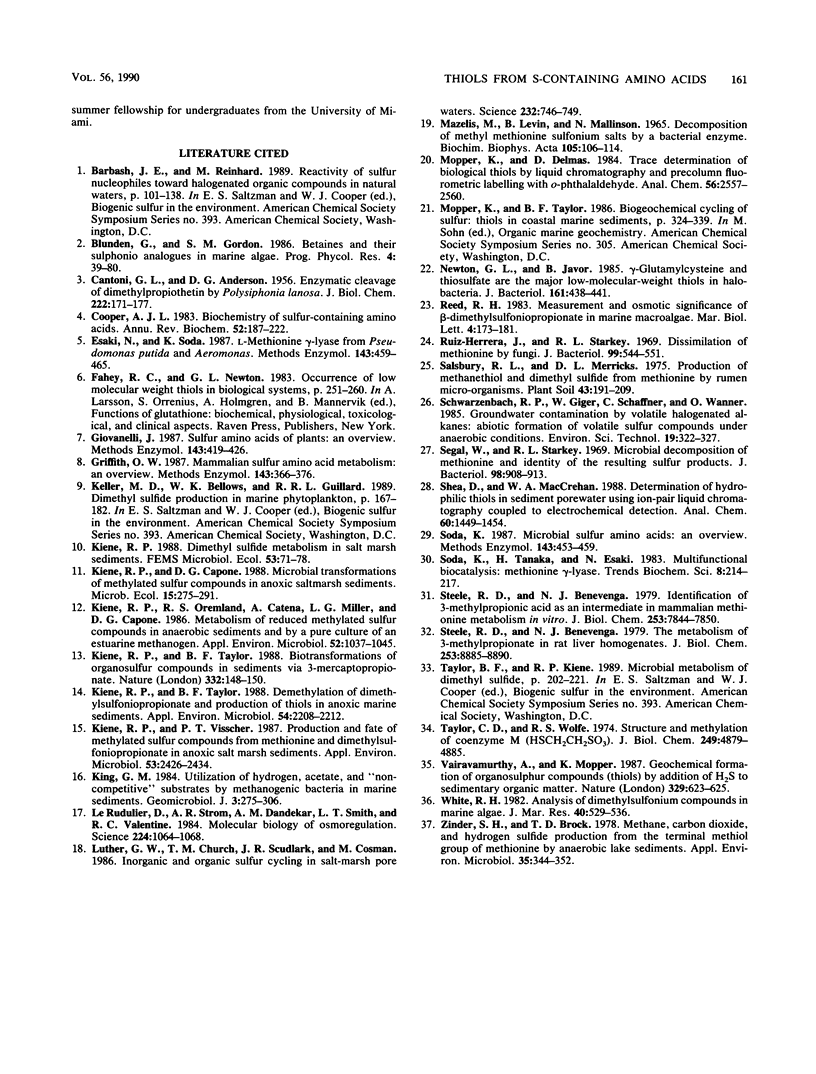
Selected References
These references are in PubMed. This may not be the complete list of references from this article.
- ANDERSON D. G., CANTONI G. L. Enzymatic cleavage of dimethylpropiothetin by Polysiphonia lanosa. J Biol Chem. 1956 Sep;222(1):171–177. [PubMed] [Google Scholar]
- Cooper A. J. Biochemistry of sulfur-containing amino acids. Annu Rev Biochem. 1983;52:187–222. doi: 10.1146/annurev.bi.52.070183.001155. [DOI] [PubMed] [Google Scholar]
- Esaki N., Soda K. L-methionine gamma-lyase from Pseudomonas putida and Aeromonas. Methods Enzymol. 1987;143:459–465. doi: 10.1016/0076-6879(87)43081-4. [DOI] [PubMed] [Google Scholar]
- Griffith O. W. Mammalian sulfur amino acid metabolism: an overview. Methods Enzymol. 1987;143:366–376. doi: 10.1016/0076-6879(87)43065-6. [DOI] [PubMed] [Google Scholar]
- Kiene R. P., Oremland R. S., Catena A., Miller L. G., Capone D. G. Metabolism of reduced methylated sulfur compounds in anaerobic sediments and by a pure culture of an estuarine methanogen. Appl Environ Microbiol. 1986 Nov;52(5):1037–1045. doi: 10.1128/aem.52.5.1037-1045.1986. [DOI] [PMC free article] [PubMed] [Google Scholar]
- Kiene R. P., Taylor B. F. Demethylation of dimethylsulfoniopropionate and production of thiols in anoxic marine sediments. Appl Environ Microbiol. 1988 Sep;54(9):2208–2212. doi: 10.1128/aem.54.9.2208-2212.1988. [DOI] [PMC free article] [PubMed] [Google Scholar]
- Kiene R. P., Visscher P. T. Production and fate of methylated sulfur compounds from methionine and dimethylsulfoniopropionate in anoxic salt marsh sediments. Appl Environ Microbiol. 1987 Oct;53(10):2426–2434. doi: 10.1128/aem.53.10.2426-2434.1987. [DOI] [PMC free article] [PubMed] [Google Scholar]
- Le Rudulier D., Strom A. R., Dandekar A. M., Smith L. T., Valentine R. C. Molecular biology of osmoregulation. Science. 1984 Jun 8;224(4653):1064–1068. doi: 10.1126/science.224.4653.1064. [DOI] [PubMed] [Google Scholar]
- Luther G. W., 3rd, Church T. M., Scudlark J. R., Cosman M. Inorganic and organic sulfur cycling in salt-marsh pore waters. Science. 1986 May 9;232(4751):746–749. doi: 10.1126/science.232.4751.746. [DOI] [PubMed] [Google Scholar]
- Mazelis M., Levin B., Mallinson N. Decomposition of methyl methionine sulfonium salts by a bacterial enzyme. Biochim Biophys Acta. 1965 Jul 29;105(1):106–114. doi: 10.1016/s0926-6593(65)80179-5. [DOI] [PubMed] [Google Scholar]
- Mopper K., Delmas D. Trace determination of biological thiols by liquid chromatography and precolumn fluorometric labeling with o-phthaladehyde. Anal Chem. 1984 Nov;56(13):2557–2560. doi: 10.1021/ac00277a064. [DOI] [PubMed] [Google Scholar]
- Newton G. L., Javor B. gamma-Glutamylcysteine and thiosulfate are the major low-molecular-weight thiols in halobacteria. J Bacteriol. 1985 Jan;161(1):438–441. doi: 10.1128/jb.161.1.438-441.1985. [DOI] [PMC free article] [PubMed] [Google Scholar]
- Ruiz-Herrera J., Starkey R. L. Dissimilation of methionine by fungi. J Bacteriol. 1969 Aug;99(2):544–551. doi: 10.1128/jb.99.2.544-551.1969. [DOI] [PMC free article] [PubMed] [Google Scholar]
- Segal W., Starkey R. L. Microbial decomposition of methionine and identity of the resulting sulfur products. J Bacteriol. 1969 Jun;98(3):908–913. doi: 10.1128/jb.98.3.908-913.1969. [DOI] [PMC free article] [PubMed] [Google Scholar]
- Soda K. Microbial sulfur amino acids: an overview. Methods Enzymol. 1987;143:453–459. doi: 10.1016/0076-6879(87)43080-2. [DOI] [PubMed] [Google Scholar]
- Steele R. D., Benevenga N. J. Identification of 3-methylthiopropionic acid as an intermediate in mammalian methionine metabolism in vitro. J Biol Chem. 1978 Nov 10;253(21):7844–7850. [PubMed] [Google Scholar]
- Steele R. D., Benevenga N. J. The metabolism of 3-methylthiopropionate in rat liver homogenates. J Biol Chem. 1979 Sep 25;254(18):8885–8890. [PubMed] [Google Scholar]
- Taylor C. D., Wolfe R. S. Structure and methylation of coenzyme M(HSCH2CH2SO3). J Biol Chem. 1974 Aug 10;249(15):4879–4885. [PubMed] [Google Scholar]
- Zinder S. H., Brock T. D. Methane, carbon dioxide, and hydrogen sulfide production from the terminal methiol group of methionine by anaerobic lake sediments. Appl Environ Microbiol. 1978 Feb;35(2):344–352. doi: 10.1128/aem.35.2.344-352.1978. [DOI] [PMC free article] [PubMed] [Google Scholar]


